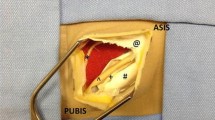Abstract
Background
Laparoscopic surgery has an important role to play in the care of patients with inguinal hernias, but the procedure is difficult to learn. This study aimed to assess whether training to proficiency using a novel laparoscopic inguinal hernia repair (LIHR) simulation curriculum improved operating room (OR) performance.
Methods
For this study, 17 surgical residents [postgraduate years (PGYs) 2–5] participated in a didactic LIHR course and then were randomized to a training (T) or a control (C, standard residency) group. Performance of totally extraperitoneal (TEP) LIHR in the OR at baseline and after the study was measured using the Global Operative Assessment of Laparoscopic Skills–Groin Hernia (GOALS-GH).
Results
Of the 17 residents, 14 (5 T and 9 C) completed their final evaluations. The two groups showed no differences in terms of LIHR experience. The baseline GOALS-GH scores in the OR were similar (T 14.8; range 12.8–16.8 vs. C 13.6; range 12.3–14.8; P = 0.20). The mean number of training sessions needed to achieve proficiency was 4.8 (range 4.4–5.2), and the mean total training time was 109 min (range 61.9–149.1 min). After training, OR performance improved in the T group by 3.4 points (range 2.0–4.8 points; P = 0.002), whereas no significant change was seen in the C group [1.2; (range −1.1 to 3.6; P = 0.27)]. The final total GOALS-GH scores showed a trend toward better performance in the T group than in the C group [18.2; (range 14.9–21.5) vs. 14.8; (range 12.4–17.1); P = 0.06).
Conclusions
This study demonstrated the skills required for transfer of LIHR to the OR using a low-cost procedure-specific simulator. Residents who trained to proficiency on the McGill Laparoscopic Inguinal Hernia Simulator (MLIHS) showed greater skill improvement than their colleagues who did not. These results provide evidence supporting the use of simulation to teach and assess LIHR.

Similar content being viewed by others
References
Reznick RK, MacRae H (2006) Teaching surgical skills: changes in the wind. N Engl J Med 355:2664–2669
Simons MP, Aufenacker T, Bay-Nielsen M, Bouillot JL, Campanelli G, Conze J, de Lange D, Fortelny R, Heikkinen T, Kingsnorth A, Kukleta J, Morales-Conde S, Nordin P, Schumpelick V, Smedberg S, Smietanski M, Weber G, Miserez M (2009) European Hernia Society guidelines on the treatment of inguinal hernia in adult patients. Hernia 13:343–403. doi:10.1007/s10029-009-0529-7
Neumayer L, Giobbie-Hurder A, Jonasson O, Fitzgibbons R, Dunlop D, Gibbs J, Reda D, Henderson W (2004) Open mesh versus laparoscopic mesh repair of inguinal hernia. N Engl J Med 350:1819–1827
The MRC Laparoscopic Groin Hernia Trial Group (1999) Laparoscopic versus open repair of groin hernia: a randomised comparison. Lancet 354:185–190
Rutkow IM (2003) Demographic and socioeconomic aspects of hernia repair in the United States in 2003. Surg Clin North Am 83:1045–1051
Jacob BP, Tong W, Reiner M, Vine A, Katz LB (2009) Single-incision total extraperitoneal (one SITE) laparoscopic inguinal hernia repair using a single-access port device. Hernia 13:571–572
Qureshi A, Vergis A, Jimenez C, Green J, Pryor A, Schlachta CM, Okrainec A (2011) MIS training in Canada: a national survey of general surgery residents. Surg Endosc 25:3057–3065
Fried GM, Feldman LS, Vassiliou MC, Fraser SA, Stanbridge D, Ghitulescu G, Andrew CG (2004) Proving the value of simulation in laparoscopic surgery. Ann Surg 240:518–528
Sroka G, Feldman LS, Vassiliou MC, Kaneva PA, Fayez R, Fried GM (2010) Fundamentals of Laparoscopic Surgery simulator training to proficiency improves laparoscopic performance in the operating room: a randomized controlled trial. Am J Surg 199:115–120
Hamilton EC, Scott DJ, Kapoor A, Nwariaku F, Bergen PC, Rege RV, Tesfay ST, Jones DB (2001) Improving operative performance using a laparoscopic hernia simulator. Am J Surg 182:725–728
Zendejas B, Cook DA, Bingener J, Huebner M, Dunn WF, Sarr MG, Farley DR (2011) Simulation-based mastery learning improves patient outcomes in laparoscopic inguinal hernia repair: a randomized controlled trial. Ann Surg 254:502–511
Kurashima Y, Feldman LS, Al-Sabah S, Kaneva PA, Fried GM, Vassiliou MC (2011) A novel low-cost simulator for laparoscopic inguinal hernia repair. Surg Innov 18:171–175
Kurashima Y, Feldman LS, Al-Sabah S, Kaneva PA, Fried GM, Vassiliou MC (2011) A tool for training and evaluation of laparoscopic inguinal hernia repair: the Global Operative Assessment of Laparoscopic Skills-Groin Hernia (GOALS-GH). Am J Surg 201:54–61
Martin JA, Regehr G, Reznick R, MacRae H, Murnaghan J, Hutchison C, Brown M (1997) Objective Structured Assessment of Technical Skill (OSATS) for surgical residents. Br J Surg 84:273–278
Ericsson KA (2008) Deliberate practice and acquisition of expert performance: a general overview. Acad Emerg Med 15:988–994. doi:10.1111/j.1553-2712.2008.00227.x
Kruger J, Dunning D (1999) Unskilled and unaware of it: how difficulties of recognizing one’s own incompetence lead to inflated self-assessments. J Per Soc Psychol 77:1121–1134
Acknowledgments
The authors thank the McGill general surgery residents for their participation in this study. We could not have completed the study without their diligence and support.
Disclosures
The salary of Yo Kurashima was funded by an unrestricted Covidien grant during the time this research was conducted, but this is not believed to have influenced the research in any way. Liane S. Feldman is a consultant for Covidien and had a centre of excellence Grant from Covidien as well as an investigator-initiated research grant from Ethicon. Pepa Kaneva had a Covidien unrestricted grant to fund research. Gerald M. Fried had an Covidien unrestricted grant to fund research, and his son works for CAE Healthcare. Melina C. Vassiliou is a Covidien consultant and had an unrestricted Grant to fund research. Simon Bergman, Sebastian V. Demyttenaere, and Chao Li have no conflicts of interest or financial ties to disclose.
Author information
Authors and Affiliations
Corresponding author
Rights and permissions
About this article
Cite this article
Kurashima, Y., Feldman, L.S., Kaneva, P.A. et al. Simulation-based training improves the operative performance of totally extraperitoneal (TEP) laparoscopic inguinal hernia repair: a prospective randomized controlled trial. Surg Endosc 28, 783–788 (2014). https://doi.org/10.1007/s00464-013-3241-8
Received:
Accepted:
Published:
Issue Date:
DOI: https://doi.org/10.1007/s00464-013-3241-8




